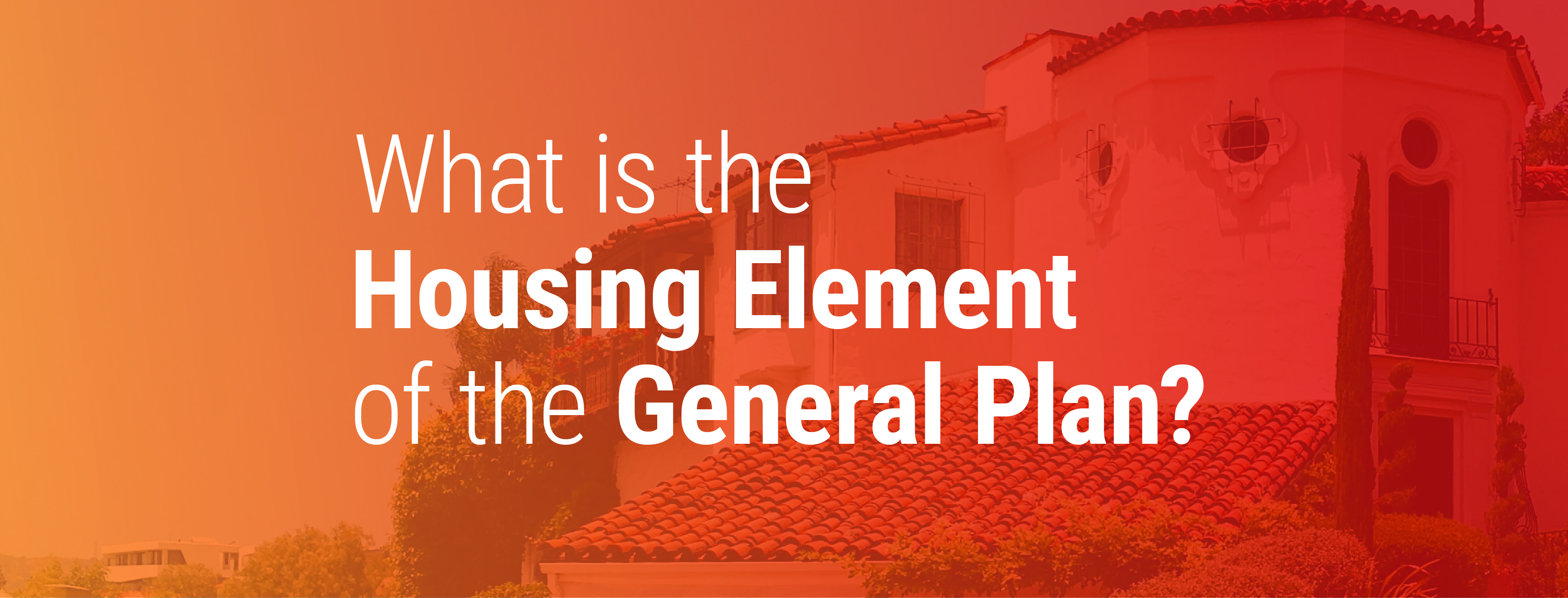
In the State of California, cities are charged with developing a General Plan to inform their decisions—everything from their housing policies to their zoning regulations.
A General Plan serves as a blueprint for the future of a city, prescribing policy goals and objectives that shape and guide its development. Like a book, the General Plan consists of chapters, which are called “elements.” Each element covers a different aspect of the urban environment, such as land use, housing, open space, or conservation.
The Housing Element is one of nine State-required components of every city’s General Plan. Unlike the other elements, the Housing Element must be updated on an eight-year schedule and be approved by the State’s Department of Housing and Community Development.
Why? Because the California State Legislature has identified the attainment of a decent home and suitable living environment for every Californian to be of vital statewide importance. After all, planning for and accommodating a city’s population, housing, and employment need is a central component of any Housing Element.
How does the Housing Element deliver on this very important task?
The Housing Element of the General Plan identifies the City’s housing conditions and needs, establishes the goals, objectives, and policies that are the foundation of the City’s housing strategy, and provides an array of programs to create sustainable, mixed-income neighborhoods across the City. One way the Housing Element affects housing supply is by setting specific housing production targets for Los Angeles through the Regional Housing Needs Assessment (RHNA) process.
During the last update to the City of Los Angeles’s Housing Element, issues related to affordability were front and center. Residents were paying more of their income for housing than ever before, at a time when federal resources to address the housing problem had also diminished dramatically.
Against this backdrop, the current Housing Element, adopted in 2013, focused on establishing housing targets around four foundational goals:
-
Goal 1: A City where housing production and preservation result in an adequate supply of ownership and rental housing that is safe, healthy, and affordable to people of all income levels, races, and ages, and suitable for their various needs.
-
Goal 2: A City in which housing helps to create safe, livable, and sustainable neighborhoods.
-
Goal 3: A City where there are housing opportunities for all without discrimination.
-
Goal 4: A City committed to ending and preventing homelessness.
The City of Los Angeles takes these responsibilities very seriously. Like many cities in California, Los Angeles is facing a shortage of affordable and market rate housing. However, guided by the goals, policies, and programs set forth in the Housing Element, Los Angeles has taken bold steps to streamline the entitlement process for all housing developments, paying special attention to projects with targeted levels of affordable units.
Through the implementation of the Housing Element, the City has developed new programs that are resulting in more affordable housing units, like the TOC Incentive Program and Affordable Housing Linkage Fee. Additionally, policies such as the Permanent Supportive Housing and Interim Motel Conversion ordinances provide streamlined pathways to housing homeless individuals and families.
Not since the late 1980s has the City produced more housing, with more units coming online than in decades past—thanks, in no small part, to the Housing Element. Historically, the Housing Element has taken great steps to address our housing challenges by establishing citywide objectives and policies—even the exploration of new programs—to inform future conversations.
While the City has made significant progress in producing more housing since the last update to the Housing Element, there is still much work to be done. Increasing homelessness and the continuing housing affordability crisis are challenges the City faces as it prepares to update the Housing Element again. This time, working with stakeholders to revisit housing goals, objectives, and policies, LA is looking ahead to 2029.
The 2021-2029 update to the Housing Element will formally launch in 2020. Over the next two years, City Planning will share numerous opportunities to participate in the update process, both in person and online. The best ways to stay informed are by signing up for the Housing Element email list and following City Planning on Facebook, Twitter, and Instagram. Spread the word and encourage friends who may be interested to sign up as well!
People who have specialized knowledge about housing in Los Angeles are encouraged to join the Housing Element Task Force. For more details, visit the application page at http://bit.ly/HousingElementTaskForce
By working together, we can guide Los Angeles to be a city of livable and sustainable neighborhoods with a range of housing types for all income levels.